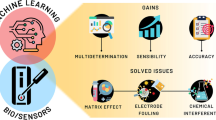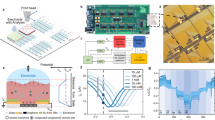Abstract
Electrochemical sensors, like ion-selective field transistors (ISFET), are electronic devices that merge solid-state electronic technology with chemical sensors so as to be sensitive to the concentration of a particular ion in a solution. However, as it has been previously reported, their response does not only depend on a single ion but also is affected by several interfering ions found in the solution to be measured. These interfering ions can be considered as noise and consequently, a post-processing stage that increases the SNR is obligatory. Our work shows how ensemble learning methods could be used in an array of chemical sensors in order to deal with this problem. In particular, we introduce a novel neural learning architecture for ISFET arrays, which employ ISFET models as prior knowledge. The proposed ensemble learning systems are RBF-like solutions based on bagging and optimal linear combination. Several experimental results are included, which demonstrate the interest and viability of the proposed solution.
Similar content being viewed by others
References
Chen, T.,et al.:Highlights of Statistical Signal and Array Processing,IEEE Signal Processing Mag. (Sep.1998),21–64.
Gardner, J.W.:Microsensors:Principles and Applications,John Wiley & Sons, Chichester, 1994.
Nagle,H.T., Schiffman, S.S. and Gutierrez-Osuna, R.:The how and why of electronic noses,IEEE Spectrum.(1998),22–31.
Gutierrez-Osuna, R.and Nagle, H.T.:A method for evaluating data-processing techni-ques for odor classi cation with an array of gas sensors,IEEE Trans.Sys.Man,Cybern. B.SMVB-29,No.5,(1999),626–632.
Wiemho¨fer, H.D. and Cammann, K.:Ion-sensitive Electrodes,In:W. Go¨pel J. Hesse and J.N. Zemel (eds.),Sensors:A Comprehensive Survey,Vol.2,Chemical and Biochemical Sensors Part I.Edited by W.Go ¨pel,T.A.Jones,M.Kleitz,J.Lundstro ¨m,T.Seiyama, VCH,Weinheim,pp.177–183,1991.
Cattrall, R.W.:Chemical Sensors,Oxford University Press, Oxford,1997.
Wilson, D.M., Hoyt, S., Janata, J., Booksh K. and Obando, L.:Chemical Sensors for Portable,Handheld Field Instruments,IEEE Sensors J.,1 (4),(December 2001).
van den Berg, A.:Ion-sensitive Field Effect Transistors,In:W. Go¨pel J. Hesse and J.N. Zemel (eds.),Sensors:A Comprehensive Survey,Vol.2,Chemical and Biochemical Sensors Part I.Edited by W.Go ¨pel,T.A.Jones,M.Kleitz,J.Lundstro ¨m,T.Seiyama,VCH, Weinheim,pp.474–501,1991.
Dybko, A.:Chemical Sensors:Technology and Metrology,Ph.D.Thesis,Department of Analytical Chemistry, Warsaw University of Technology,2001.
Baucke, F.G.K., Naumann, R. and Alexander-Weber, Ch.:Multiple-point calibration with linear regression as a proposed standardization procedure for high-precision pH measurements,Anal.Chem.65 (1993),3244–3251.
Sharkey, A. (ed.).:Combining Artificial Neural Nets,Springer-Verlag, Berlin,1999.
Breiman, L.:The Heuristics of Instability in Model Selection,Ann.Stat.,24 (1997), 2350–2381.
Breiman, L.:Bias-Variance,Regularization,Instability and Stabilization,In:C.M. Bishop (ed.),Neural Networks and Machine Learning,NATO ASI Series,Series F: Computer and Systems Sciences,Vol.168,Springer-Verlag, Berlin,1998.
Geman,S., Bienenstock, E. and Doursat, R.:Neural Networks and the bias/variance dilemma,Neural Comp.4 (1992).
Breiman, L.:Bagging Predictors,Machine Learning.26 No.2,(1996),734–751.
Natftaly, U., Intrator, N., Horn, D.:Optimal Ensemble Averaging of Neural Networks, Technical Report,Israel Institute of Technology,(1997).
Hashem, S.:Optimal linear combinations of neural networks,Neural Networks,10 (4), (1997),599–614.
Bergveld, P.:Development of an Ion-sensitive solid-state device for neurophysiological measurements,IEEE Trans.Biomed.Eng.BME-17 (1970),70–71.
Warner, R.M. Jr. and Grung, B.L.:MOSFET:Theory and Design,Oxford University Press, New York,1999.
Bousse, L., de Rooij, N.F. and Bergveld, P.:Operation of chemically sensitive eld-effect sensors as a function of the insulator-electrolyte interface,IEEE Trans.Electron.Devices. ED-30 (1983),1263–1273.
Smith, R.L. and Scott, D.C.:An integrated sensor for electrochemical measurements, IEEE Trans.Biomed.Eng.BME-33 (1986),83–90.
Sibbald, A.:Chemical-sensitive eld-effect transistors,IEE Proceedings.130 (5),Part I (1983),233–244.
Martinoia, S. and Massobrio, G.:A behavioral macromodel of the ISFET in SPICE, Sens.Act.B.62 (2000),182–189.
Brzo´zka, Z., Holterman, A.J., Honing, W.N., Verkerk, U.H., can den Vlekkert, H.H., Engbersen, J.F.J. and Reinholut, D.N.:Enhanced performance of potassium CHEM-FET by optimization of a polysiloxane membrane,Sens.Act.B.18–19 (1994),38–41.
Opalski,L.J.:Personal communication.
Pala´n, B., Santos, F.V., Karam, J.M., Courtois, B. and Husa´k, M.:New ISFET sensor interface circuit for biomedical applications,Sens.Act.B.57 (1999),36–42.
Chin, Y.-L., Chou, J.-C., Sun, T.-P., Liao, H.-K., Chung, W.-Y. and Hsiung, S.-K.: A novel SnO2/Al discrete gate ISFET pH sensor with CMOS standard process,Sens.Act. B 75 (2001),36–42.
Author information
Authors and Affiliations
Corresponding author
Rights and permissions
About this article
Cite this article
Bermejo, S., Cabestany, J. Ensemble Learning for Chemical Sensor Arrays. Neural Processing Letters 19, 25–35 (2004). https://doi.org/10.1023/B:NEPL.0000016844.22502.a8
Issue Date:
DOI: https://doi.org/10.1023/B:NEPL.0000016844.22502.a8




